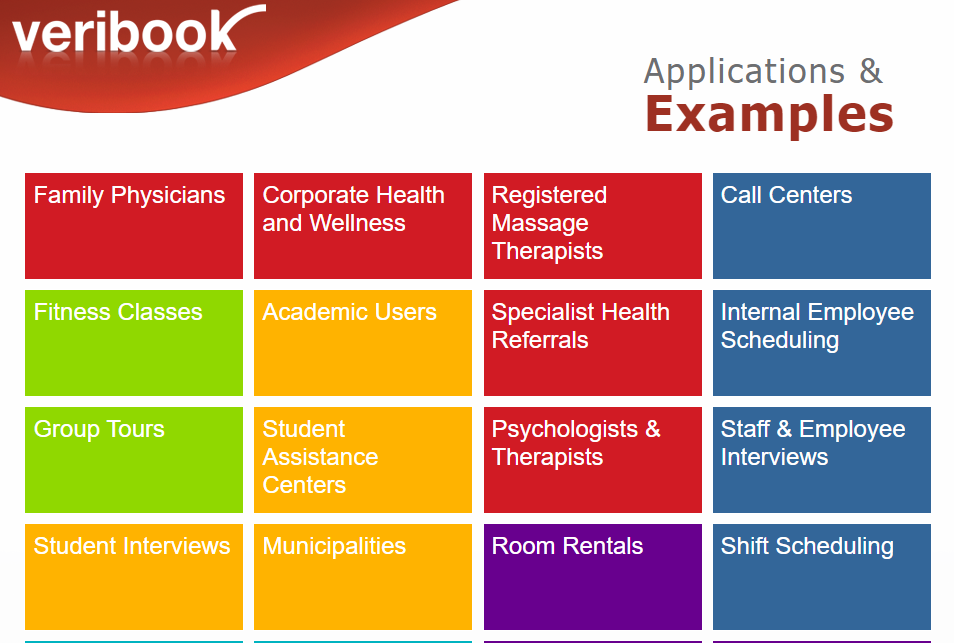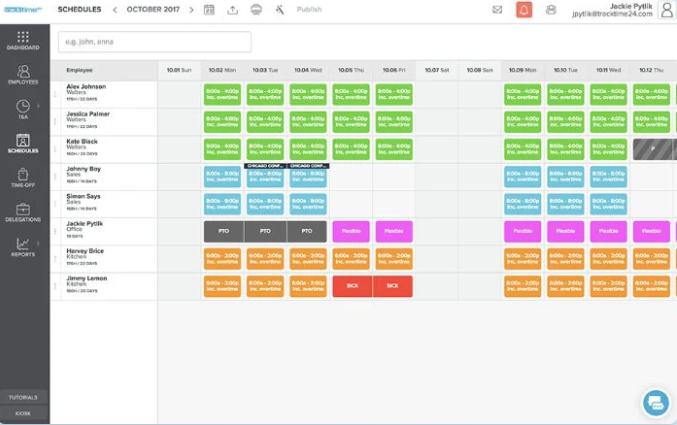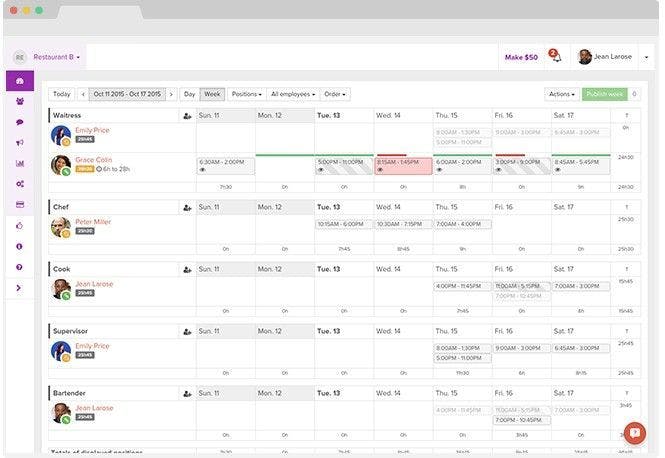
How to Make a Scheduling App or Web-based Software for Employees Scheduling?
Traditional 9-to-5 workflow models are becoming outdated, as the increasing number of employees choose to move towards a flexible schedule. Teams prefer to be result-driven rather than manage their productivity by time. When there is no fixed schedule for the entire team, organizing meetings and brainstorming sessions gets difficult as there are rare moments when all employees are present in the workplace.
To keep track of this complex and increasingly flexible schedule, employees use web-based staff scheduling software. Let’s take a look at how to build a scheduling app, how such platforms facilitate management and team organization and bring benefits to employees individually.

1. Adapting to changes in schedules
Whenever employees need to take a break or sick day, they can make an update to their profile on a scheduling software and the manager will immediately see this update, as well as all the team members who have access to the data. A manager doesn’t have to notify the entire team that the member will be missing — this data will be automatically displayed on the platform.
Employees have higher visibility of their team schedules, and managers can plan group activities with regards to these shifts. Automation of schedule tracking also saves a lot of time — team members don’t have to send emails or calls with absence alerts. The chances of errors are also much lower — an email can get lost, but an update in the centralized platform won’t be missed as easily.
2. Long-term records of time-offs
Managers often experience difficulties evaluating how much time employees spend at the office. When the team switches to flexible schedules, some employees might use it to their advantage and spend much less time in the office than their colleagues do. To keep track of such behaviors, managers can get regular reports of the number of logged-in hours.
Managers can approve or decline several time-off requests simultaneously without having to call a team member. Instead of taking up hours, these management activities can be completed in 5-15 minutes.
3. Distributing team members on shifts
On certain establishments, such as restaurants or hospitals, some hours require more available staff members. Managers can take these peak moments into account by assigning more members to busy hours and reducing employee involvement on free days. Such practice allows us to optimize spending on human resources — this way you don’t pay for unnecessary hours and don’t struggle with understaffing during busy periods.
With regular reports, a business manager can track employee activities at any given moment and determine the distribution of the workload through the day, changing the approach to shift planning.
4. Improve employee satisfaction by putting the team in control
Employees prefer flexible schedules to fixed work hours because it gives them more freedom. However, having to report about each break or time-out doesn’t let them fully enjoy that independence. Employee self-services provide them with control and put team members in charge of their attendance.
Business owners can save their budgets by cutting off unnecessary intermediaries, allowing managers who control attendance and presence, to focus on strategic tasks instead. Employees can substitute each other, align their schedules, and get updates on other employee activity — all without bothering a manager.
5. Improved monitoring
Web-based scheduling services provide the manager with superior means of analyzing employees’ attendance. Rather than constantly checking up on them, a manager can export an attendance report and use tangible data for further planning.
This way, both managers and team members receive more control over scheduling and attendance. Every team member has access to transparent numeric data on all logged-in hours and can adjust their schedules according to these statistics.

HOW TO CREATE A SCHEDULING APP
Building scheduling software is relevant for organizations with more complex requirements and work shifts, such as restaurants, hotels, schools, hospitals, construction companies, or any others which have employees with hourly rates or different working schedules.
The business manager and any team member should be able to access and export detailed reports on regular shifts. It’s best if the software provides data on each employee individually along with the entire team’s hour count. The manager should be able to see the bigger picture and analyze overall productivity, but also, zoom into personal statistics. So, how to code a scheduling app and what features should the system have?
Managing schedules
The software should be capable of scheduling meetings, track projects, control budgeting, and employee workloads. The manager can add events to the employee’s schedule, and the team member should be immediately notified about these changes. The feature should also work vice versa — when the employee adds a task or event, the team leader receives an alert and can approve or decline the update.
Real-time communication
Automated scheduling systems should leave space for direct communication between an employee and manager. This includes messaging, emails, and calls — the software should keep communication logs and automatically spot the time and date of meetings and days-off, if these are mentioned in the message or letter.
Shift management
The employee scheduling web app should assign shifts automatically to free team members and notify them about upcoming work hours. If there is an urgent task, the software has to immediately alert the user via push-notification, email, or even call.
Also, the platform should allow employees to swap their shifts without a manager’s assistance. The software should keep track of possible double-booking, alerting managers and employees about possible duplications.
Saving schedule templates
Teams often stick to the same shift schedules and daily routines. Managers should be able to plan those automatically, without having to re-enter the same data every day or week. As soon as the shift schedule was approved, the team leader can save it into a template and re-paste it for the next days or weeks.
Reports, analytics, forecasts
Web-based scheduling tools should provide business owners with smart insights on their team’s organization, based on collected statistics. For instance, the software can identify members that were overworked or underworked and suggest changes to their schedules. It should also provide managers with financial reports, HR statistics, and real-time data comparison. These reports are usually visualized in graphs, diagrams, and infographics.
Applying organization restrictions
Some businesses require a certain number of employees to be always present in the workplace. For instance, an open restaurant should have at least one chef in the workplace, while hospitals have strict standards about the number of doctors and nurses on call. Automated scheduling software must keep track of these requirements and remind team managers to add more employees in case of understaffing.
Scheduling tools should also keep track of legal restrictions — the Labor Code requires team managers to arrange not more than three night shifts in a row to a single worker as well as no more than seven consecutive workdays.
HOW TO START SCHEDULING SOFTWARE DEVELOPMENT
Web-based scheduling software offer various levels of functionality complexity. Some of them are only limited to scheduling and monitoring while others integrate task management features. Let’s take a look at steps of building a basic scheduling software design that allows a reasonable level of detail in time tracking.
Scheduler
It’s the feature that allows adding new events to employee calendars, managing their activity, and keeping track of logged-in hours. A scheduler allows settings regular shift intervals — a day, week, months, and provide a view on workers who are assigned to a certain task, location, and time. The interface is typically a calendar that can be customized and shared, similar to Google Planner.
Employee profiles
The second most important feature is a personal employee page with personal and content information, job titles, background information, skills, and availability. Some platforms also include task and time reports, as well as access to email and messenger profiles. Each member should be able to preview their own page and view profiles of other users. Levels of authorization can regulate the access to profiles of other members, although it’s better to keep files transparent to all employees.
Auto-assign feature
The manager will be able to automate the scheduling and assigning process. The tool will automatically distribute shifts among employees based on their availability, previous shifts, qualifications. Employees should receive immediate notifications about a new shift and be able to decline it with an explanation.
Peer-to-peer shift swap
Employees should be able to exchange shifts without bothering the employer. This requires the combination of real-time updates of personal profiles, shared calendar, and messaging features. Also, the tool should be integrated with email tools and messengers — so that a manager and employees can be immediately alerted about swap updates.
Flexible availability
Employees should have editing permissions for editing their workloads and shifts, signaling when they will be able to work. The manager can choose to be alerted immediately about any change or receive a joint report at the end of the day.
Time-off alerts
An employee should be able to specify a time-off day and time in the personal schedule and availability dates. A manager should have the full statistics of member’s overall availability and attendance. If an employee is calling too many sick-days or time-offs, it’s reasonable to question the person’s productivity. Preferably, the tool should count these time-offs and whenever the count passes a critical threshold, the employee and employer should receive warnings.
A secure database
All these time reports and numeric data should be safely stored in the Cloud storage, where it can be shared with a desktop or mobile device anytime and anywhere. So even an employee who’s not in the office can track schedules with a smartphone.
Time clock
The employees should be able to track their time on an hourly basis, similarly to Hubstaff developers can integrate ready time-tracking features instead of developing custom tools from scratch.

Examples of an employee scheduling web app on the market
Before you start developing a custom web-based staff scheduling system, we recommend taking a look at existing open source employee scheduling software features along with paid tools. When thinking about how to make a scheduling website, you can analyze their features and possibilities and see what you would add or remove in your solution.
Veribook
Veribook is a schedule management software for small businesses and individuals. The software allows scheduling team meetings, appointments, consults, and keeping track of overtimes and time-offs.
Features
- Highly customizable scheduling
- Displays a business’ real-time availability
- Ability to accept and manage appointments and recurring appointments
- No-show tracking

TrackTime24
This is a timeclock software that makes real-time sheets and schedules for the entire team. The software allows recording clock-ins and outs, calculating total hour counts, and excluding breaks and sick days. Employees can update their work schedules in real-time and managers receive regular reports.
Features
- Absence management, vacation/leave tracking
- Employee time clock, overtime, and hourly tracking
- Benefits, compensation, and payroll
- Contractor management

MySchedule.com
MySchedule is a simple web-based scheduling program for small teams and individuals. Managers can approve the availability of their employers, review their activities, and create automated schedules. The application sends overtime warnings and provides regular productivity reports.
Features
- An option to swap shifts
- Clock-in and clock-out
- Vacation or leave tracking

Ubeya
Ubeya is an app for managing work schedules and tracking work time regularly. The application allows managing shift trades, availability, and time-offs. Timesheets can be edited in real-time both by employees and managers, and the app sends push-notifications to the smartphone. Also, Ubeya has a built-in payroll tool that calculates hourly, flat, and global rates, as well as keeps basic financial documentation.
Features
- An outline of employees, events, timing, payroll, and analytics
- Synchronization with the calendar
- GPS clock-in and clock-out

Agendrix
This platform provides employees mobile access to their schedules, allows to communicate with the manager and other team members as well as receive prompt notifications. The application has the GPS-control as well as time schedules, and timesheets. Agendrix allows viewing schedules of other members, synchronizing your schedule with a personal phone planner.
Features
- Remote access
- Changing shifts between employees
- Clock-in and clock-out
- Vacation, absence and leave tracking

Our experience
Developing a custom schedule solution has a lot of benefits, compared to using an existing tool. The software can be adjusted to your market, team, and workloads, and budget, and be easily accessed from any browser and device.
Gearheart is ready to share expertise in developing a web based scheduling program, automated tools, and enabling start data-tracking. As an experienced web development provider, we know how to build a scheduling web app and pack rich functionality into an intuitive interface. Our developers combine existing APIs with unique code to make a cost-efficient and personalized platform.
To get started with smart schedule tracking or get more answers on how to develop a scheduling software, just drop us a line — our experts will consult you on the functionality, platform’s logic, and interface. We will analyze your company's needs and develop a solution that fits your business needs.




